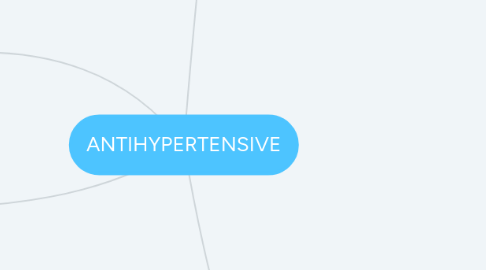
1. VASODILATORS
1.1. CCBs
1.2. HYDRALAZINE
1.3. MINOXIDIL
1.4. Na NITROPRUSSIDE
1.5. DIAZOXIDE
2. DRUGS INHIBITING ANGIOTENSIN ACTIVITY
3. ALTERED SODIUM AND WATER EXCRETION
3.1. DIURETICS- can lower BP by 10-15mmHg. Reduce dietary Na intake.
3.1.1. THIAZIDES
3.1.1.1. MOA:nhibits NaCl reabsprption; inhibits Na/Cl symporter, distal convulated tubule
3.1.1.2. S/E:Hypokalemia, hyperuricemia(gout)
3.1.1.3. C/Is: Diabetics & hyperlipidemia
3.1.1.4. Indapamide preferred in diabetic patients with renal impairment where an ACEI can't be used, and has benefits: vasodilation leading to increased renal perfusion; less side effects than HTCZ.
3.1.1.5. Indication: Mild to moderate HTN as mono
3.1.2. LOOP DIURETICS
3.1.2.1. MOA: same with thiazides, Na/K/2Cl co-transporter, thick ascending loop
3.1.2.2. S/Es:Same as Thiazides + hypomagnesameia, ototoxicity, allergic rxns
3.1.2.3. D/Is: Digoxin and NSAIDs
3.1.2.4. Difference: Loops are high ceiling, therefore incr. in dose=incr. in response. Loop diuretics have vasodilatory effects due to PGI2 thus used in pulmonary oedema and renal impairment. loops are short acting, thus rapid vasodilatory effects leading to compensatory mechanism
3.1.3. POTASSIUM SPARING
3.1.3.1. Indication: Severe HTN/ when there is renal impairment(increased perfusion) with cardiac failure. Also combination therapy (+ beta blocker) due to compensatory mechanism.
3.1.3.2. MOA: Aldosterone antagonism in the collecting duct, leading to more water and Na excretion
3.1.3.3. S/Es: Hyperkalemia, hyperchloraemia, acute renal failure, kidney stones (triamterene), gynaecomastia(Just spironolactone, inhibits the secretion of androgen in males,causing oestrogen to dominate; switch to eplerenone), although effective in Conns syndrome, liver and HF
3.1.3.4. Used with thiazides (cause hypokalemia) to minimise electrolyte imbalances
4. ALTERED SNS FUNCTION
4.1. INHIBITORS OF RAAS
4.1.1. ACE INHIBITORS
4.1.1.1. MOA:Block ACE from converting angiotensin I to angiotensin ||, leading to vasodilation by reducing PVR, and therefore reduce BP, reduce bradykinin breakdown which increases endothelial prod. of NO and PG, thus increased vasodilation
4.1.1.2. S/Es: Dry hacking cough, angiodema(both due to bradykinin), hypotension, taste disturbances, Hyperkalemia(K sparing effect)
4.1.1.3. Indications: Captopril in HTN comorbid with DM. No compensatory mechanism thus safe in IHD. HF and post MI. Best in DM with microalbuminaemia since they reduce the BP in the efferent arteriole.
4.1.1.4. C/Is: renal artery stenosis they worsen renal function by decreasing intraglomerular pressure. Pregnancy.
4.1.2. ARBs
4.1.2.1. MOA: Bind to AngII type I receptor, preventing vasoconstriction and aldosterone secretion, thus reducing PVR, and reducing BP.
4.1.2.2. S/Es:Hypotension, dizziness, taste disturbances, hyperkalemia (K sparing effect). No dry hacking cough or angiodema.
4.1.2.3. Indications: Same as ACEIs, and where ACEIs are not tolerated
4.1.3. RENIN INHIBITORS
4.1.3.1. Beta Blockers
4.1.4. ALDOSTERONE ANTAGONISTS
4.1.4.1. Spironolactone, eplerenone
4.2. SYMPATHOLYTICS
4.2.1. ALPHA RECEPTOR ANTAGONISTS
4.2.1.1. MOA: acts as antagonists at alpha-1 receptors, causing vasodilation, resulting in decreased PVR, this decreases BP
4.2.1.2. S/Effects: Dizziness, palpitations, orthostatic hypotension, Na and water retention due to activation of RAAS as a compensatory mechanism
4.2.2. BETA RECEPTOR ANTAGONISTS
4.2.2.1. MOA: Antagonize B1 receptor of the heart, reducing the ionotropic and chronitropic effect, reducing cardiac output and overally BP. Also act in the renal, prevent renin secretion, inhibiting RAAS, decreasing PVR and lowers BP.
4.2.2.2. S/Es- Bradycardia, heart block, bronchospasm, peripheral vascular insufficiency, masks symptoms of hypoglycaemia and increases glucose intolerance, causes dyslipidemia, exercise intolerance (decreased cardiac conduction) cross BBB, causes depression
4.2.2.3. Withdrawal symptoms: prolonged use and abrupt stopping, leads to nervousness, tachycardia, angina, increased BP and MI. This is due to upregulation of beta receptors
4.2.2.4. Propranolol is highly lipophillic, and is non selective, thus causes CNS side effects e.g. depression, and worsens asthma/PVD/masking hypoglycaemia. Acebutolol is a partial agonist, thus decreases asthma exacerbations and decreases benefit in post MI.
4.2.3. MIXED ALPHA AND BETA
4.2.3.1. Labetolol & Carvedilol
4.2.3.1.1. MOA: Bind to alpha1 (blood vessels) and cause vasodilation; beta1 receptors(kidneys), cause reduced renin (angiotensin II) thus decreasing vasoconstriction/since there is no aldpsterone, there is decreased Na and H2O reabsorption, thus reduces blood volume, CO and BP. In the heart, B1 receptors blockade results in decreased HR thus decreased CO
4.2.3.1.2. Indications:Labeteolol (Beta3:Alpha1)is used in HTN emergencies(IV), phaechromocytoma associated HT. Carvedilol (non-selective), lipophillic (cns s/effects) longer acting, anti-oxidant properties. indications: HF and HTN.Alpha 1 blockade 1st then Beta blockade to reduce reflex tachycardia
4.2.4. CENTRALLY ACTING AGENTS
4.2.4.1. Methyldopa
4.2.4.1.1. MOA: Analogue of L-Dopa (precursor of noradrenaline)
4.2.5. ADRENERGIC NEURON BLOCKING AGENTS

